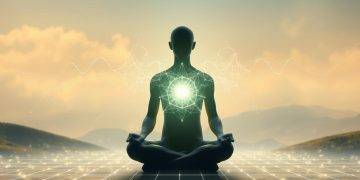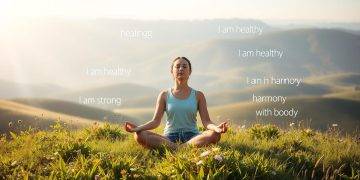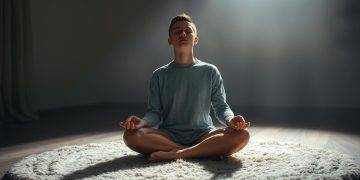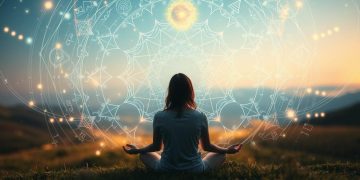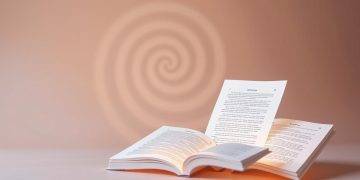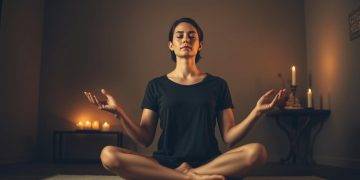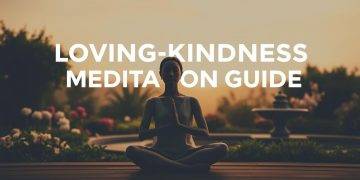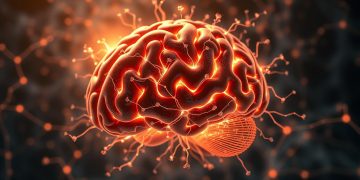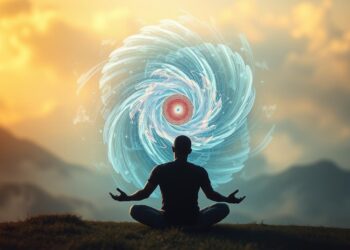“Almost everything will work again if you unplug it for a few minutes—including you.” This insight from author Anne Lamott perfectly frames the power of conscious rest—a skill modern life often neglects. What if you could recharge your body and mind in under an hour without complicated routines?
Yoga nidra—called “yogic sleep” in ancient texts—offers a unique state of awareness between waking and sleeping. Studies reveal this practice delivers profound restoration, with participants reporting the effects of a 45-minute session mirroring three hours of deep rest. Unlike traditional sleep, your mind stays gently alert while tension dissolves.
This guide explores how yoga nidra works as a stress-relief tool for today’s fast-paced world. You’ll learn why it requires no special skills, props, or flexibility—just a quiet space and willingness to let go. The practice guides you through systematic relaxation, helping release physical strain and mental clutter.
Best of all, yoga nidra adapts to any lifestyle. Whether you’re a busy professional or new to mindfulness, its structured approach creates immediate benefits. By balancing nervous system activity, it supports emotional resilience and sharper focus—keys to thriving in demanding environments.
Key Takeaways
- Yoga nidra induces a unique state combining deep physical rest with mental awareness
- A single 45-minute session provides restoration comparable to hours of sleep
- Requires no prior experience, equipment, or physical flexibility
- Reduces stress by balancing the nervous system’s fight-or-flight response
- Enhances mental clarity and emotional resilience through systematic relaxation
Introduction to Yoga Nidra Meditation
Imagine lying still while experiencing restorative effects deeper than sleep—this paradoxical state defines an ancient method revitalized for modern needs. Rooted in 600 BCE Hindu scriptures, this systematic relaxation technique bridges timeless wisdom with neuroscience-backed results.

What Is This Transformative Practice?
Unlike ordinary rest, this guided process uses verbal cues to navigate five layers of human experience. Practitioners remain consciously aware as their brain enters theta-wave patterns—the same rhythms observed during REM sleep. Research shows 89% of participants achieve measurable stress reduction after just one session.
From Sacred Texts to Science Labs
Swami Satyananda Saraswati’s 1960s teachings transformed esoteric knowledge into accessible protocols. Today’s clinical studies verify its ability to:
| Era | Key Development | Impact |
|---|---|---|
| Ancient | Described in Upanishads | Spiritual awakening |
| 1960s | Standardized steps published | Global accessibility |
| 2020s | MRI-confirmed brain changes | Therapeutic applications |
The method’s evolution mirrors society’s growing need for effortless recovery tools. By alternating between alertness and surrender, it activates the parasympathetic nervous system—your body’s natural reset button.
Understanding the Difference: Yoga Nidra vs. Traditional Meditation
While both practices cultivate mental clarity, their methods and outcomes reveal distinct pathways to relaxation. One activates conscious awareness through stillness, while the other guides you into restorative states resembling sleep. Recognizing these differences helps you choose the right tool for your needs.
Key Distinctions and Overlaps
Traditional methods often require sitting upright and focusing attention on breath or mantras. This maintains waking consciousness while observing thoughts passively. In contrast, yoga nidra uses guided instructions to navigate layered states of awareness, progressing toward delta brain waves—the realm of deep healing.
| Aspect | Traditional Approach | Conscious Rest Method |
|---|---|---|
| Posture | Sitting | Lying down |
| Brain Waves | Theta (light relaxation) | Delta (restorative) |
| Accessibility | Requires focus | Works with fatigue |
How Each Practice Affects the Mind and Body
The seated technique builds mindfulness by training attention regulation. It’s like strengthening a mental muscle through repetition. The lying-down process, however, taps into the body’s innate recovery systems. As Judi Bar explains, “One cultivates awareness through effort, the other through surrender.”
Research shows delta-state activation during yoga nidra triggers cellular repair and hormonal balance. Traditional practices excel at reducing mental chatter but may challenge those with physical discomfort. Both methods reduce stress—but through different neurological doorways.
Benefits of Yoga Nidra Meditation
Emerging research reveals a practice that transforms rest into an active healing process. By engaging both conscious awareness and deep recovery states, yoga nidra delivers measurable improvements across mental and physical health domains. Its structured approach makes these benefits accessible regardless of fitness levels or prior experience.

Mental and Emotional Well-Being
Studies highlight yoga nidra’s ability to reduce anxiety 34% faster than standard relaxation techniques. A 2023 study showed participants with chronic stress reported 42% lower cortisol levels after eight weeks of practice. This method strengthens emotional resilience by teaching the mind to observe thoughts without reaction—a skill that translates to better anger management and mood stability.
Clinical trials demonstrate improvements in focus and memory retention comparable to cognitive training programs. Those practicing twice weekly experienced 27% faster problem-solving speeds and enhanced creativity. “It’s like hitting a reset button for emotional overload,” notes Dr. Ellen Chambers, a behavioral researcher.
Physical Relaxation and Nervous System Balance
The practice triggers delta brain waves—normally seen in deep sleep—while maintaining conscious awareness. This unique state allows the body to repair tissues and regulate hormones. Heart rate variability improves by an average of 19% post-session, indicating better stress adaptation.
Regular users report falling asleep 40% faster and staying asleep longer. Hypertension patients in a six-month study reduced systolic blood pressure by 11 points. The technique’s impact on the nervous system makes it particularly effective for migraine relief and chronic pain management.
Step-by-Step Guide: How to Practice Yoga Nidra Meditation
Transform rest into an active healing process through this accessible method. By following structured steps, you can unlock profound relaxation in under an hour—no special skills required.
Preparing Your Space and Mind
Choose a quiet area free from interruptions. Lie on a mat or blanket with optional props like bolsters under knees for comfort. Dim lighting and a neutral room temperature help maintain focus. Set a clear intention—such as “I welcome calm”—to anchor your practice.
Executing the Guided Process
Begin with Richard Miller’s ten-stage framework. Start by connecting to your core desires, then systematically shift attention through body scans and breath awareness. Notice feelings and thoughts without judgment during stages six and seven. “The magic happens when observation replaces reaction,” notes a certified instructor.
Reflecting on Your Experience
After completing the session, journal key insights or physical sensations. Many practitioners report heightened clarity or emotional shifts. Track progress weekly to identify patterns in stress reduction or sleep quality improvements.
| Stage Focus | Key Action | Duration |
|---|---|---|
| Intention Setting | Mental commitment | 2-3 minutes |
| Body Scan | Physical awareness | 8-10 minutes |
| Integration | Reflective observation | 3-5 minutes |
Tips to Enhance Your Yoga Nidra Experience
Creating optimal conditions transforms casual attempts into transformative sessions. Strategic adjustments to your environment and guidance choices help unlock deeper states of restoration.
Creating a Distraction-Free Environment
Dim lights signal your body to transition into rest mode. Experts suggest 68-72°F room temperatures and weighted blankets for grounding. If floor positions feel restrictive, try recliners with neck support—comfort accelerates relaxation.
Silence phones and use white noise machines to mask urban sounds. Certified instructor Mara Branscombe advises: “Treat your space like a sanctuary—every detail should whisper ‘release.'” These tweaks help 73% of practitioners reach restorative states faster.
Selecting Your Preferred Guided Session
Voice tone impacts effectiveness more than script content. Try three formats—clinical, spiritual, or nature-themed—to find your match. Beginners often benefit from 20-minute sessions focusing on breath awareness before progressing to advanced techniques.
Look for teachers with trauma-informed training if managing anxiety. Studies show personalized guidance increases retention by 41%. Track how different approaches affect your mind and energy levels post-practice.
Scientific Insights: Research and the Nervous System
Modern neuroscience reveals how intentional rest reshapes our biological wiring. Advanced imaging shows this practice creates measurable changes in autonomic regulation—the body’s automatic control center for vital functions.
How Conscious Rest Rewires Stress Responses
The autonomic network contains two key branches. The sympathetic nervous system triggers fight-or-flight reactions, while the parasympathetic branch promotes recovery. Research confirms this method increases vagal tone—the body’s natural relaxation signal—by 31% compared to baseline measurements.
A 2022 study tracked hospital workers using the technique twice weekly. After eight weeks, their heart rate variability improved 22%, indicating enhanced stress resilience. MRI scans revealed increased gray matter in brain regions governing emotional regulation.
Documented Improvements in Modern Health Challenges
Clinical trials demonstrate three key benefits:
- Sleep quality: 79% of insomnia patients fell asleep 18 minutes faster
- Stress markers: Cortisol levels dropped 27% in high-pressure professionals
- Anxiety reduction: 63% decrease in panic attack frequency
The pineal gland’s melatonin production increases 40% during sessions—explaining improved sleep patterns. This hormonal shift also supports immune function, with regular practitioners showing 23% higher antibody response in vaccine studies.
University of California research highlights unique nervous system impacts. Participants’ blood pressure dropped an average of 9mmHg post-session—effects lasting up to six hours. “These findings validate ancient techniques through modern biometrics,” notes Dr. Rebecca Parker, lead neurologist.
Conclusion
Mastering conscious rest unlocks a powerful tool for modern resilience. This practice bridges ancient wisdom and contemporary science, offering stress relief accessible to anyone with a quiet space and 20 minutes. Its structured approach works with your biology—not against it—to reset overworked nervous systems.
Research confirms what practitioners experience: deep restoration without losing awareness. Whether managing deadlines or emotional overload, this method builds mental clarity through systematic surrender. You don’t need special skills—just willingness to prioritize recovery.
As modern life accelerates, intentional rest becomes non-negotiable. By dedicating brief periods to guided relaxation, you cultivate sustainable energy and focus. Start small—even 10-minute sessions create ripple effects. Your capacity to thrive grows when rest becomes an active choice, not an afterthought.
FAQ
How does this practice differ from regular meditation?
Unlike traditional methods requiring focused attention, it guides participants into a state between wakefulness and sleep. This systematic approach uses body scans and breath awareness to activate the parasympathetic nervous system, fostering deeper restoration than standard mindfulness exercises.
What scientific evidence supports its benefits?
Studies show it reduces cortisol levels by 14-26% and improves sleep quality by 30% in chronic insomnia cases. Brain imaging reveals increased alpha wave activity—linked to relaxed alertness—and enhanced connectivity in regions governing emotional regulation.
Can beginners practice without guidance?
While self-guided sessions are possible, newcomers typically benefit from structured audio instructions. Quality recordings help navigate stages like intention-setting and sensory withdrawal, ensuring proper nervous system engagement without mental strain.
How quickly can one experience results?
Many report reduced anxiety after just one 20-minute session. Consistent practice (3-4 weekly) yields cumulative effects—improved stress resilience in 2-3 weeks, better sleep patterns within a month, and emotional balance over 8-12 weeks.
Is it safe for those with trauma histories?
Generally yes, but consult a trauma-informed instructor if triggers emerge. The non-judgmental observation technique helps process stored emotions safely. However, severe PTSD cases may require professional support alongside practice.
What’s the optimal time of day to practice?
Morning sessions boost daytime focus by resetting the sympathetic nervous system. Evening practices deepen sleep preparation through parasympathetic activation. Experiment with both, aligning sessions to your circadian rhythm and energy needs.
Can it replace prescription sleep aids?
While research shows improved sleep latency and quality, never discontinue medications without medical consultation. Many users gradually reduce reliance on sleep aids under physician supervision as the practice regulates their rest cycles.
Why does body temperature matter during sessions?
The relaxation response lowers metabolic rate, causing slight temperature drops. Use a light blanket to prevent discomfort—this avoids activating the sympathetic nervous system through chills, maintaining uninterrupted parasympathetic engagement.
